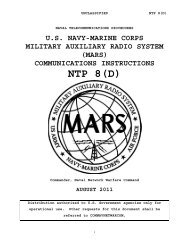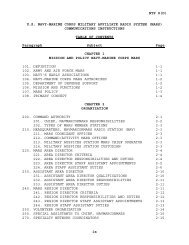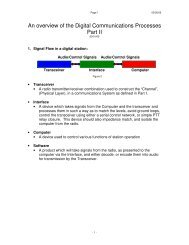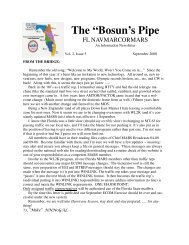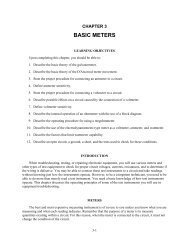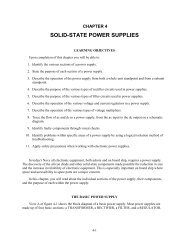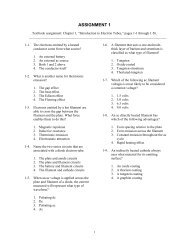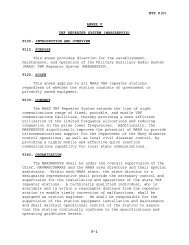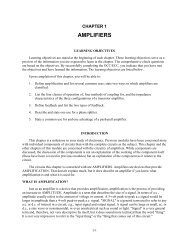grid-leak biasing, there is one thing you should bear in mind. Because the bias is derived from thepositive input signal through capacitive action, the input signal must go through several positivealternations before the final operating bias voltage is achieved. We will explain why this is so in thefollowing discussion.View A of figure 1-25 shows the circuit under quiescent conditions. You will notice that the circuitis similar to the one we used to explain the action of a triode. The only additions are the grid resistor, R gcoupling capacitor, C c , and resistance rgk. Resistance rgk doesn't exist as a physical component, but it isused to represent the internal tube resistance between the triode's cathode and grid. Electrically, rgk isquite small, about 500 ohms. Under quiescent conditions, some conduction occurs through the tube. Someelectrons will strike the wires of the grid, and a small amount of GRID CURRENT will flow through R gto ground. This will cause the right-hand plate of C c to go slightly negative. This slight negative chargewill, in turn, keep the grid of the tube slightly negative. This limits the number of electrons that strike thegrid wires.Figure 1-25.—Shunt grid-leak biasing.In view B of the figure, the first positive alternation of a series of ac alternations, E in is applied to thecircuit. The positive-going voltage causes the left-hand plate of C c to go positive. The left-hand plate mustlose electrons to go positive. These electrons leave the left-hand plate of C c and travel to the input sourcewhere they will be coupled to ground. From ground, current flows through R g causing a negative (bottom)to positive (top) voltage drop across R g . In effect, the ac signal has been coupled across the capacitor.Because of this, capacitors are said to pass the ac signal while blocking dc. (In reality, the ac signal iscoupled around the capacitor.) In view C of the figure, the positive-going voltage at the top of R g will becoupled to the grid causing the grid to go positive. The positively charged grid will attract electrons fromthe electron stream in the tube. Grid current will flow from the grid to the right-hand plate of C c . This willcause the right-hand plate to go negative. (Electrostatic repulsion from the right-hand plate of C c willforce electrons from the left-hand plate of C c , causing it to go positive.) The electrons will flow throughthe signal source, to ground, from ground to the cathode, from the cathode to the grid, and finally to the1-34
ight-hand plate of C c . This is the biasing charge cycle. You may wonder why the charge current wentthrough the tube rather than through R g . When the grid goes positive in response to the positive-goinginput signal, electrostatic attraction between the grid and cathode increases. This, in turn, reduces theresistance (rgk) between the grid and cathode. Current always follows the path of least resistance. Thus,the capacitor charge path is through the tube and not through R g .When the first negative alternation is applied to the circuit (view D), the left-hand plate of C c mustgo negative. To do this, electrons are drawn from the right-hand plate. The electrons travel from theright-hand plate of C c , through R g causing a voltage drop negative (top) to positive (bottom), from thebottom of R g , through the source, to the left-hand plate of C c . C c will discharge for the duration of thenegative alternation. BUT C c can only discharge through R g , which is a high-resistance path,compared to the charge path. Remember from your study of capacitors that RC time constants and therate of discharge increase with the size of R. C c can therefore charge through the low resistance of rgk toits maximum negative value during the positive half-cycle. Because C c discharges through R g (the highresistance path), it cannot completely discharge during the duration of the negative half-cycle. As a result,at the completion of the negative alternation, C c still retains part of the negative charge it gained duringthe positive alternation. When the next positive alternation starts, the right-hand plate of C c will be morenegative than when the first positive alternation started.During the next cycle, the same process will be repeated, with C c charging on the positive alternationand discharging a lesser amount during the negative alternation. Therefore, at the end of the second cycle,C c will have an even larger negative charge than it did after the first cycle. You might think that thecharge on C c will continue to increase until the tube is forced into cutoff. This is not the case. As thenegative charge on the right-hand plate of C c forces the grid more negative, electrostatic attractionbetween the grid and cathode decreases. This, in effect, increases the resistance (rgk) between the cathodeand the grid, until rgk becomes, in effect, the same size as R g . At this point, charge and discharge of C cwill equal one another and the grid will remain at some negative, steady voltage. What has happened inthis circuit is that C c and R g , through the use of unequal charge and discharge paths, have acted to changethe ac input to a negative dc voltage. The extent of the bias on the grid will depend on three things: theamplitude of the input, the frequency of the input, and the size of R g and C c . This type of biasing has theadvantage of being directly related to the amplitude of the input signal. If the amplitude increases, biasingincreases in step with it. The main limiting factor is the amount of distortion that you may be willing totolerate. Distortion occurs during the positive alternation when the grid draws current. Current drawnfrom the electron stream by the grid never reaches the plate; therefore the negative-going output is not afaithful reproduction of the input, while the positive-going output (during the negative input cycle) will bea faithful reproduction of the input. This is similar to the situation shown in the flattopped portion of theoutput signal in figure 1-20.The SERIES GRID-LEAK BIAS circuit shown in figure 1-26 operates similarly to the shunt gridleakcircuit. When the first positive alternation is applied to the left-hand plate of the grid capacitor, C g ,the left-hand plate must lose electrons to go positive with the input. Electrons will leave the left-handplate and flow through R g , causing a negative (left-hand side) to positive (right-hand side) voltage drop.From the right-hand side of R g , the electrons will flow to the right-hand plate of C g . The positive voltagedeveloped at the right-hand side of R g will be coupled to the grid. As the grid goes positive, it will drawcurrent, causing C g to start to charge through the low resistance path of the tube. During the negativealternation of the input, C g will discharge through the high resistance path of R g . Once again it will not becompletely discharged at the end of the negative alternation, and the capacitor will continue on its waytoward charge equilibrium.1-35




